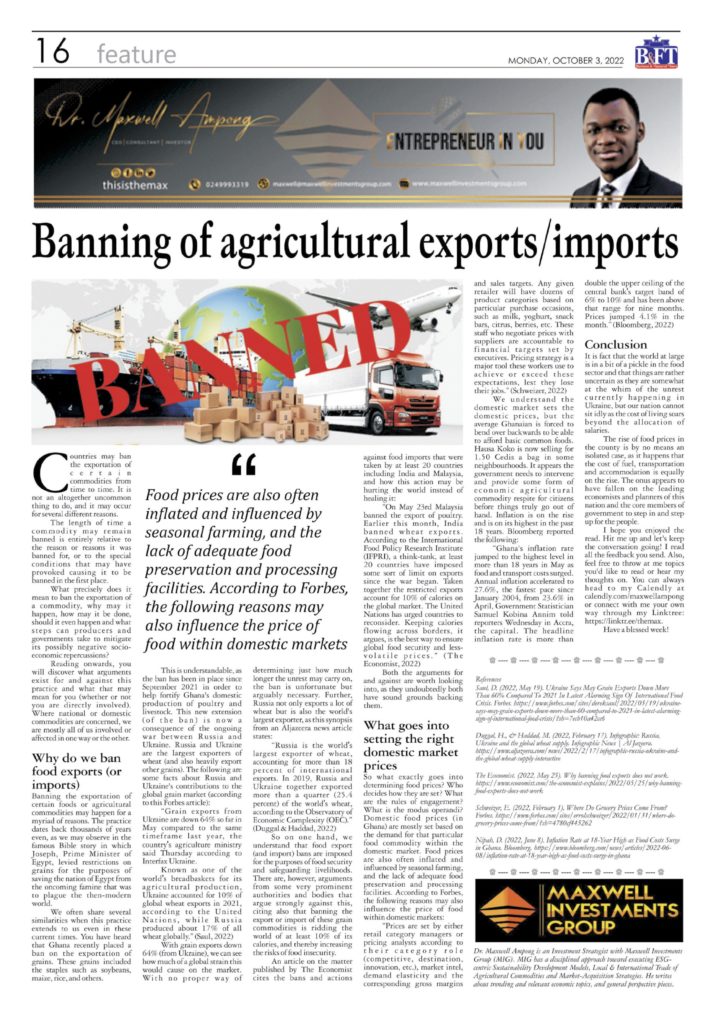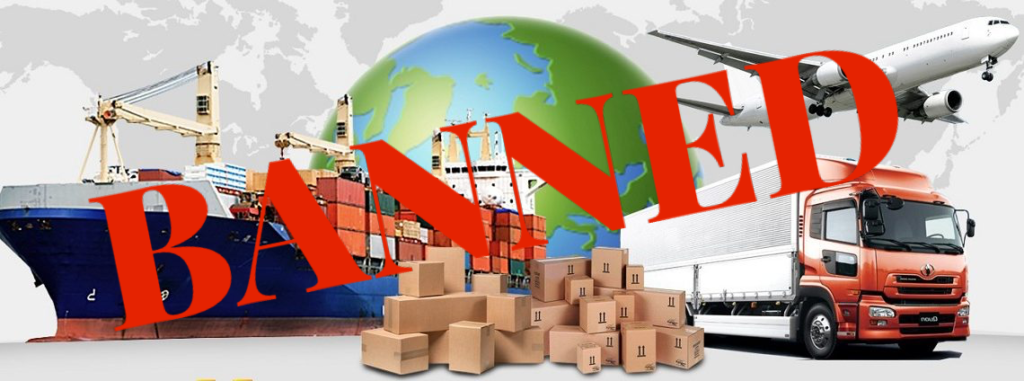
Countries may ban the exportation of certain commodities from time to time. It is not an altogether uncommon thing to do, and it may occur for several different reasons.
The length of time a commodity may remain banned is entirely relative to the reason or reasons it was banned for, or to the special conditions that may have provoked causing it to be banned in the first place.
What precisely does it mean to ban the exportation of a commodity, why may it happen, how may it be done, should it even happen and what steps can producers and governments take to mitigate its possibly negative socio-economic repercussions?
Reading onwards, you will discover what arguments exist for and against this practice and what that may mean for you (whether or not you are directly involved). Where national or domestic commodities are concerned, we are mostly all of us involved or affected in one way or the other.
Why do we ban food exports (or imports)
Banning the exportation of certain foods or agricultural commodities may happen for a myriad of reasons. The practice dates back thousands of years even, as we may observe in the famous Bible story in which Joseph, Prime Minister of Egypt, levied restrictions on grains for the purposes of saving the nation of Egypt from the oncoming famine that was to plague the then-modern world.
We often share several similarities when this practice extends to us even in these current times. You have heard that Ghana recently placed a ban on the exportation of grains. These grains included the staples such as soybeans, maize, rice, and others.
This is understandable, as the ban has been in place since September 2021 in order to help fortify Ghana’s domestic production of poultry and livestock. This new extension (of the ban) is now a consequence of the ongoing war between Russia and Ukraine. Russia and Ukraine are the largest exporters of wheat (and also heavily export other grains). The following are some facts about Russia and Ukraine’s contributions to the global grain market (according to this Forbes article):
“Grain exports from Ukraine are down 64% so far in May compared to the same timeframe last year, the country‘s agriculture ministry said Thursday according to Interfax Ukraine.
Known as one of the world‘s breadbaskets for its agricultural production, Ukraine accounted for 10% of global wheat exports in 2021, according to the United Nations, while Russia produced about 17% of all wheat globally.” (Saul, 2022)
With grain exports down 64% (from Ukraine), we can see how much of a global strain this would cause on the market. With no proper way of determining just how much longer the unrest may carry on, the ban is unfortunate but arguably necessary. Further, Russia not only exports a lot of wheat but is also the world’s largest exporter, as this synopsis from an Aljazeera news article states:
“Russia is the world’s largest exporter of wheat, accounting for more than 18 percent of international exports. In 2019, Russia and Ukraine together exported more than a quarter (25.4 percent) of the world’s wheat, according to the Observatory of Economic Complexity (OEC).” (Duggal & Haddad, 2022)
So on one hand, we understand that food export (and import) bans are imposed for the purposes of food security and safeguarding livelihoods. There are, however, arguments from some very prominent authorities and bodies that argue strongly against this, citing also that banning the export or import of these grain commodities is ridding the world of at least 10% of its calories, and thereby increasing the risks of food insecurity.
An article on the matter published by The Economist cites the bans and actions against food imports that were taken by at least 20 countries including India and Malaysia, and how this action may be hurting the world instead of healing it:
“On May 23rd Malaysia banned the export of poultry. Earlier this month, India banned wheat exports. According to the International Food Policy Research Institute (IFPRI), a think-tank, at least 20 countries have imposed some sort of limit on exports since the war began. Taken together the restricted exports account for 10% of calories on the global market. The United Nations has urged countries to reconsider. Keeping calories flowing across borders, it argues, is the best way to ensure global food security and less-volatile prices.“ (The Economist, 2022)
Both the arguments for and against are worth looking into, as they undoubtedly both have sound grounds backing them.
What goes into setting the right domestic market prices
So what exactly goes into determining food prices? Who decides how they are set? What are the rules of engagement? What is the modus operandi? Domestic food prices (in Ghana) are mostly set based on the demand for that particular food commodity within the domestic market. Food prices are also often inflated and influenced by seasonal farming, and the lack of adequate food preservation and processing facilities. According to Forbes, the following reasons may also influence the price of food within domestic markets:
“Prices are set by either retail category managers or pricing analysts according to their category role (competitive, destination, innovation, etc.), market intel, demand elasticity and the corresponding gross margins and sales targets. Any given retailer will have dozens of product categories based on particular purchase occasions, such as milk, yoghurt, snack bars, citrus, berries, etc. These staff who negotiate prices with suppliers are accountable to financial targets set by executives. Pricing strategy is a major tool these workers use to achieve or exceed these expectations, lest they lose their jobs.” (Schweizer, 2022)
We understand the domestic market sets the domestic prices, but the average Ghanaian is forced to bend over backwards to be able to afford basic common foods. Hausa Koko is now selling for 1.50 Cedis a bag in some neighbourhoods. It appears the government needs to intervene and provide some form of economic agricultural commodity respite for citizens before things truly go out of hand. Inflation is on the rise and is on its highest in the past 18 years. Bloomberg reported the following:
“Ghana’s inflation rate jumped to the highest level in more than 18 years in May as food and transport costs surged. Annual inflation accelerated to 27.6%, the fastest pace since January 2004, from 23.6% in April, Government Statistician Samuel Kobina Annim told reporters Wednesday in Accra, the capital. The headline inflation rate is more than double the upper ceiling of the central bank’s target band of 6% to 10% and has been above that range for nine months. Prices jumped 4.1% in the month.” (Bloomberg, 2022)
Conclusion
It is fact that the world at large is in a bit of a pickle in the food sector and that things are rather uncertain as they are somewhat at the whim of the unrest currently happening in Ukraine, but our nation cannot sit idly as the cost of living soars beyond the allocation of salaries.
The rise of food prices in the county is by no means an isolated case, as it happens that the cost of fuel, transportation and accommodation is equally on the rise. The onus appears to have fallen on the leading economists and planners of this nation and the core members of government to step in and step up for the people.
I hope you enjoyed the read. Hit me up and let’s keep the conversation going! I read all the feedback you send. Also, feel free to throw at me topics you’d like to read or hear my thoughts on. You can always head to my Calendly at calendly.com/maxwellampong or connect with me your own way through my Linktree: https://linktr.ee/themax.
Have a blessed week!
♕ —- ♕ —- ♕ —- ♕ —- ♕ —- ♕ —- ♕ —- ♕ —- ♕
References
Saul, D. (2022, May 19). Ukraine Says May Grain Exports Down More Than 60% Compared To 2021 In Latest Alarming Sign Of International Food Crisis. Forbes. https://www.forbes.com/sites/dereksaul/2022/05/19/ukraine-says-may-grain-exports-down-more-than-60-compared-to-2021-in-latest-alarming-sign-of-international-food-crisis/?sh=7ecb10a42cc6
Duggal, H., & Haddad, M. (2022, February 17). Infographic: Russia, Ukraine and the global wheat supply. Infographic News | Al Jazeera. https://www.aljazeera.com/news/2022/2/17/infographic-russia-ukraine-and-the-global-wheat-supply-interactive
The Economist. (2022, May 25). Why banning food exports does not work. https://www.economist.com/the-economist-explains/2022/05/25/why-banning-food-exports-does-not-work
Schweizer, E. (2022, February 1). Where Do Grocery Prices Come From? Forbes. https://www.forbes.com/sites/errolschweizer/2022/01/31/where-do-grocery-prices-come-from/?sh=4780cf445262
Nipah, D. (2022, June 8). Inflation Rate at 18-Year High as Food Costs Surge in Ghana. Bloomberg.https://www.bloomberg.com/news/articles/2022-06-08/inflation-rate-at-18-year-high-as-food-costs-surge-in-ghana

